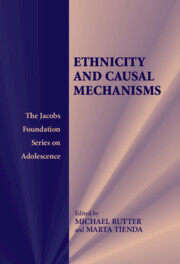Book contents
- Frontmatter
- Contents
- List of Contributors
- Foreword
- Preface
- 1 Natural Experiments, Causal Influences, and Policy Development
- 2 Growing Up Ethnic in the United Kingdom and the United States: Comparative Contexts for Youth Development
- 3 The Multiple Facets of Ethnicity
- 4 Educational Attainments: Ethnic Differences in the United Kingdom
- 5 Race and Ethnic Inequality in Educational Attainment in the United States
- 6 Racial and Ethnic Disparities in Crime and Delinquency in the United States
- 7 Explaining Ethnic Variations in Crime and Antisocial Behavior in the United Kingdom
- 8 Cultural Differences in the Effects of Physical Punishment
- 9 Ethnicity and Mental Health: The Example of Schizophrenia in the African-Caribbean Population in Europe
- 10 Ethnic Variations in Youth Suicide
- 11 Ethnicity and Intergenerational Identities and Adaptations in Britain: The Socio-Political Context
- 12 Assimilation, Dissimilation, and Ethnic Identities: The Experience of Children of Immigrants in the United States
- 13 Deciphering Ethnicity: Reflections on Research Opportunities
- Author Index
- Subject Index
10 - Ethnic Variations in Youth Suicide
Published online by Cambridge University Press: 05 July 2014
- Frontmatter
- Contents
- List of Contributors
- Foreword
- Preface
- 1 Natural Experiments, Causal Influences, and Policy Development
- 2 Growing Up Ethnic in the United Kingdom and the United States: Comparative Contexts for Youth Development
- 3 The Multiple Facets of Ethnicity
- 4 Educational Attainments: Ethnic Differences in the United Kingdom
- 5 Race and Ethnic Inequality in Educational Attainment in the United States
- 6 Racial and Ethnic Disparities in Crime and Delinquency in the United States
- 7 Explaining Ethnic Variations in Crime and Antisocial Behavior in the United Kingdom
- 8 Cultural Differences in the Effects of Physical Punishment
- 9 Ethnicity and Mental Health: The Example of Schizophrenia in the African-Caribbean Population in Europe
- 10 Ethnic Variations in Youth Suicide
- 11 Ethnicity and Intergenerational Identities and Adaptations in Britain: The Socio-Political Context
- 12 Assimilation, Dissimilation, and Ethnic Identities: The Experience of Children of Immigrants in the United States
- 13 Deciphering Ethnicity: Reflections on Research Opportunities
- Author Index
- Subject Index
Summary
Suicide is the third leading cause of death among American youth in the 15 to 24 age group. While the overall youth suicide rate has nearly doubled since 1960, the rate for African American youth has tripled, yet is still lower than the rate for non-Hispanic Whites (Centers for Disease Control, 2001). However, with the exception of Native American youth, the rates for other ethnic minority youth have remained fairly stable over the past 4 decades, and Black youth are still less likely than White youth to commit suicide or engage in suicidal behavior.
An examination of youth suicide rates in the United States reveals a curious paradox: Since 1960 African American youth, both males and females, have consistently recorded lower rates than White youth despite their relatively greater exposure to multiple risk factors and behaviors that are associated with youth suicide (Dryfoos, 1990; Garland & Zigler, 1993). Although the gap in suicide rates between White and non-White males has narrowed since the mid-1980s, the differences persist in the face of continuing racial discrimination, family poverty, and exposure to stressful environments that disproportionately affect the health and mental health of youth of color (see Gibbs & Huang, 2003; U.S. Department of Health and Human Services, 2001).
The purpose of this chapter is to examine this seeming paradox of lower suicide rates among Black youth in a society in which they are economically and socially disadvantaged and lack access to affordable health care.
- Type
- Chapter
- Information
- Ethnicity and Causal Mechanisms , pp. 262 - 280Publisher: Cambridge University PressPrint publication year: 2005
- 1
- Cited by



